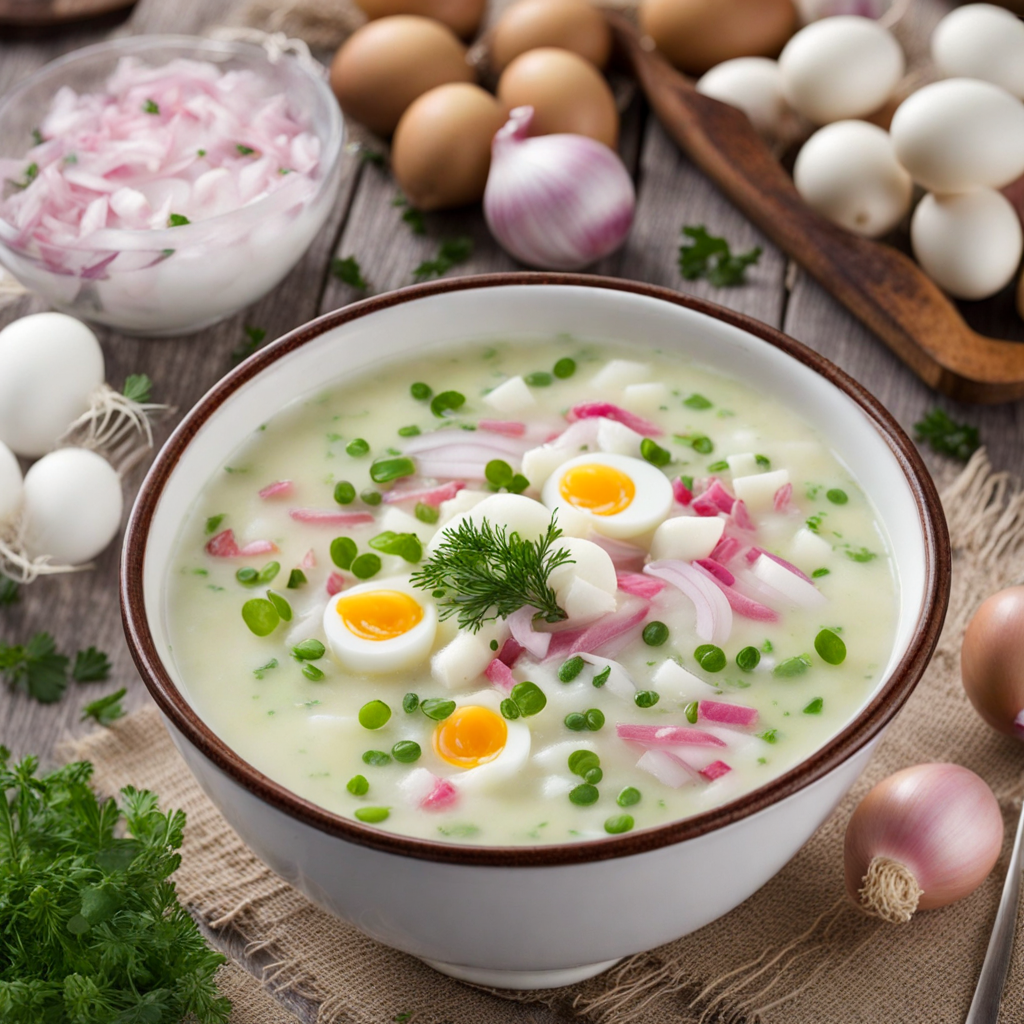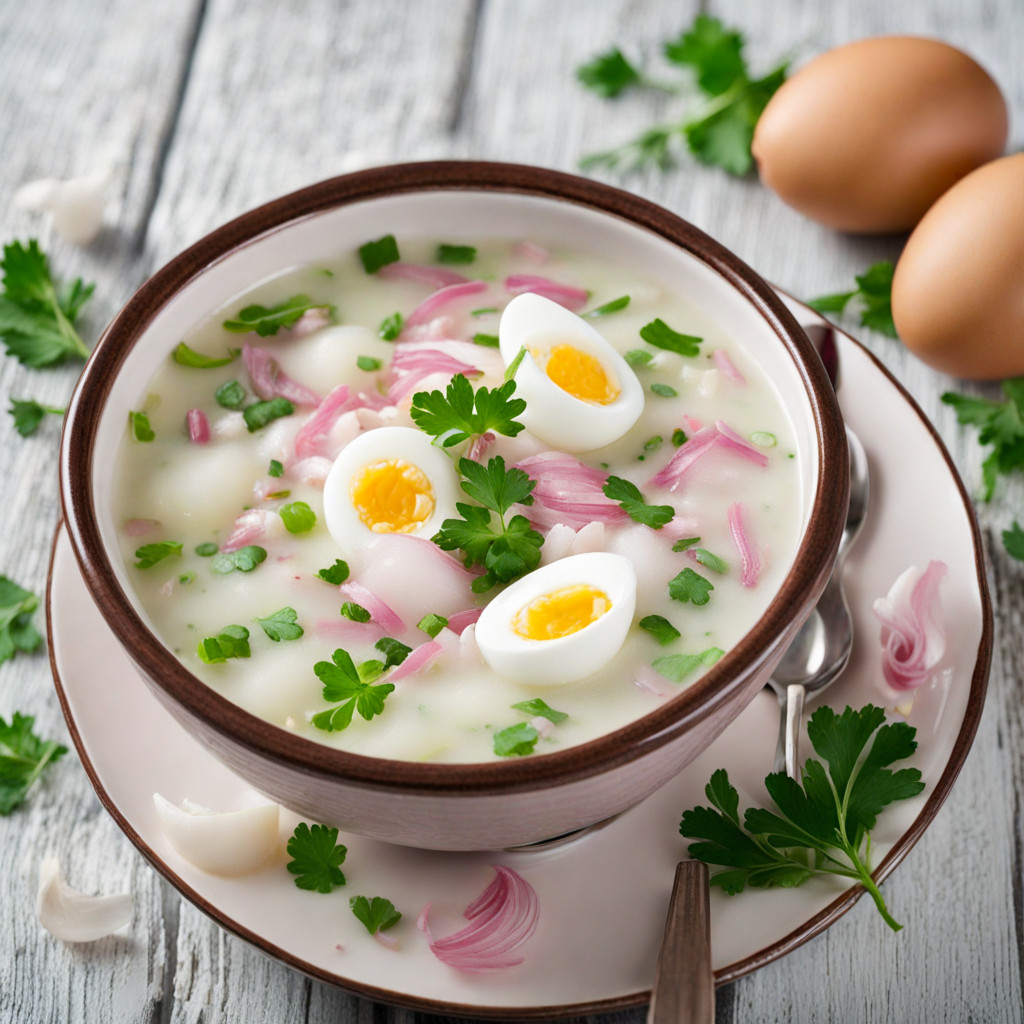Okroshka
Okroshka is a refreshing cold soup that originates from Ukraine, celebrated for its vibrant flavors and invigorating qualities, particularly during the warm months. This dish typically combines finely chopped raw vegetables such as cucumbers, radishes, and spring onions with boiled potatoes and hard-boiled eggs. The use of these fresh ingredients creates a colorful medley that is visually appealing and tantalizing to the palate, making it a perfect choice for those seeking a light yet satisfying meal. What sets Okroshka apart is its unique broth, which is usually a blend of kvass—a traditional fermented beverage made from rye bread—or kefir, a tangy yogurt-like drink. This base lends a slight acidity that complements the crisp vegetables beautifully. The soup is often seasoned with fresh dill and parsley, enhancing its aromatic profile and adding a hint of earthiness. Some variations may include diced meats like sausage or ham, providing a heartier twist to the classic recipe. Served chilled, Okroshka is not only refreshing but also versatile. It can be garnished with a dollop of sour cream for added creaminess or a sprinkle of mustard for a touch of heat. Each spoonful offers a delightful crunch, a burst of flavor, and a satisfying contrast of textures, making it an excellent option for anyone looking to explore new tastes. Whether enjoyed as a light lunch or a starter at a summer gathering, Okroshka embodies the spirit of Ukrainian cuisine with its emphasis on fresh ingredients and bold flavors.
How It Became This Dish
Okroshka: A Chilled Culinary Tradition from Ukraine Okroshka, a refreshing cold soup, is a delightful dish that has long been celebrated in Ukrainian cuisine, though its roots extend across Eastern Europe. With its unique blend of fresh vegetables, herbs, and a base of kvass or buttermilk, Okroshka is not just a meal; it embodies the essence of seasonal eating and communal dining. Let us delve into the history, cultural significance, and evolution of this beloved dish. Origins of Okroshka The origins of Okroshka can be traced back to ancient Slavic culinary traditions. The word "okroshka" itself comes from the Russian verb "kroshit," meaning "to chop." This reflects the dish's fundamental preparation method, where ingredients are finely chopped and mixed together. The earliest forms of okroshka likely emerged in the rural households of Eastern Europe, where frugality and resourcefulness in cooking were essential for survival. Traditionally, Okroshka was prepared during the hot summer months when fresh vegetables were abundant, making it a perfect dish for the sweltering heat. The inclusion of kvass, a fermented beverage made from rye bread, not only provided a refreshing taste but also added nutritional value and probiotic benefits. Kvass has been a staple in Slavic diets for centuries, often considered a "poor man's drink" but beloved by all for its unique flavor. Cultural Significance Okroshka is more than just a dish; it is a symbol of communal gatherings and family meals. In Ukrainian culture, meals are often a time for connection and sharing stories. Okroshka is typically served in a large bowl, allowing everyone at the table to help themselves, fostering a sense of togetherness. This communal aspect is essential in Ukrainian culture, where family bonds are cherished, and food plays a central role in social interaction. The dish is often prepared for special occasions such as holidays, summer picnics, and family gatherings. It is particularly popular during the Orthodox Christian feast of Ivan Kupala, a midsummer festival celebrated with food, music, and dancing. On these occasions, families would prepare Okroshka as a way to celebrate the bounty of summer and to enjoy the pleasures of outdoor life. Ingredients and Variations The beauty of Okroshka lies in its versatility. While the base ingredients typically include boiled potatoes, carrots, radishes, cucumbers, and various herbs like dill and parsley, the dish can be adapted to suit personal preferences and seasonal availability. Proteins such as boiled eggs, diced ham, or cooked sausage are commonly added, but vegetarian versions are equally popular. The choice of liquid base can also vary. While kvass is traditional, buttermilk, yogurt, or even mineral water can be used, depending on regional customs and individual tastes. Each variation brings its own character to the dish, reflecting the local ingredients and culinary practices of the area. In Ukraine, Okroshka stands out for its specific regional variations. In the western regions, a sweeter version might be made with a touch of sugar or honey, while the southern areas may lean towards a spicier preparation. This adaptability not only showcases the dish's culinary diversity but also illustrates the regional identities within Ukraine. Development Over Time As Ukraine underwent significant social and political changes, so too did its culinary landscape. The Soviet era brought about a standardization of many traditional foods, and Okroshka was no exception. During this time, the dish became associated with Soviet-era cookbooks and was often presented as a staple of Russian cuisine, leading to some misunderstanding about its origins. However, the late 20th and early 21st centuries saw a resurgence of interest in traditional recipes and local foods, coinciding with a broader movement towards embracing national identity and heritage. Chefs and home cooks alike began to rediscover Okroshka, experimenting with new ingredients and techniques while paying homage to its historical roots. This revival not only bolstered the dish's popularity in Ukraine but also contributed to its recognition on the international stage. Ukrainian restaurants around the world began to feature Okroshka on their menus, introducing this chilled soup to a global audience. Food festivals and cultural events have further cemented its status, showcasing the dish as a staple of Ukrainian culinary heritage. Contemporary Interpretations In recent years, Okroshka has evolved, reflecting contemporary culinary trends. Chefs are experimenting with flavor profiles, incorporating ingredients like avocado or even seafood, offering a modern twist on this traditional dish. Vegan and gluten-free versions have also emerged, ensuring that Okroshka remains accessible to a diverse audience. Moreover, social media has played a pivotal role in the revival of interest in Okroshka. Food bloggers and influencers share visually appealing presentations of the dish, often highlighting its vibrant colors and fresh ingredients. This has sparked curiosity and prompted many to recreate the dish at home, further solidifying its place in modern culinary discussions. Conclusion Okroshka is not merely a cold soup; it is a testament to the resilience and adaptability of Ukrainian culinary traditions. Rooted in history, this dish encapsulates the spirit of community, the importance of seasonal eating, and the enduring connection to one's cultural heritage. As it continues to evolve, Okroshka serves as a delicious reminder of the past while embracing the flavors of the present. Whether enjoyed during a family gathering or at a trendy restaurant, Okroshka remains a cherished part of Ukrainian cuisine, inviting all to partake in its refreshing embrace.
You may like
Discover local flavors from Ukraine







